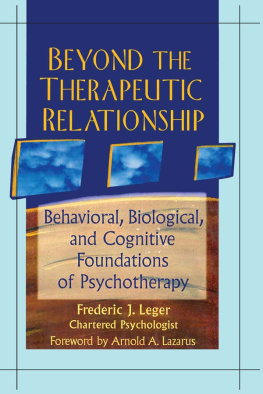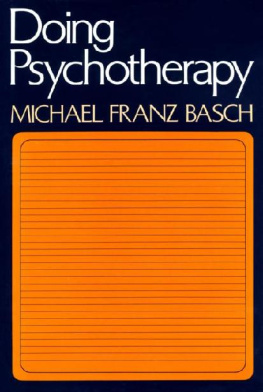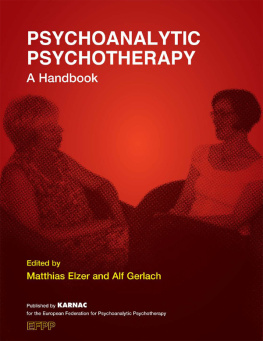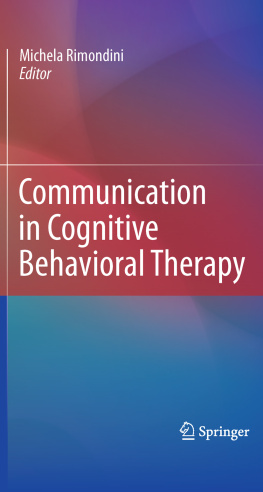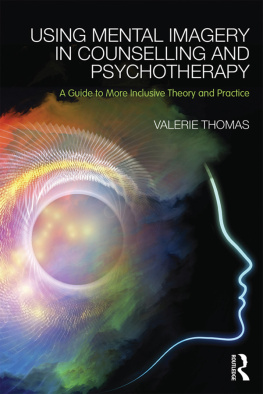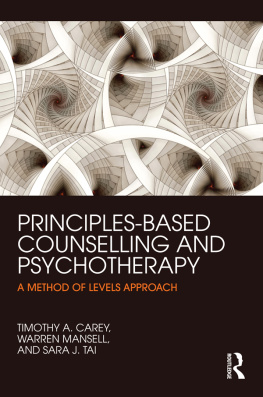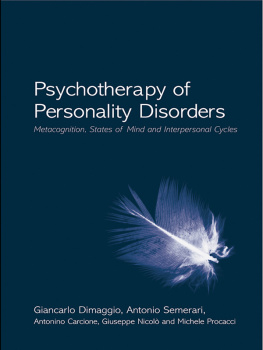Beyond the Therapeutic Relationship
Behavioral, Biological, and Cognitive Foundations of Psychotherapy
Frederic J. Leger
Foreword by
Arnold A. Lazarus
First published nam 1998 by The Haworth Press, Inc.
Published 2013 by Routledge
2 Park Square, Milton Park, Abingdon, Oxon OX14 4RN
711 Third Avenue, New York, NY 10017, USA
Routledge is an imprint of the Taylor & Francis Group, an informa business
1998 by The Haworth Press, Inc. All rights reserved. No part of this work may be reproduced or utilized in any form or by any means, electronic or mechanical, including photocopying, microfilm and recording, or by any information storage and retrieval system, without permission in writing from the publisher.
Cover design by Monica Seifert.
Library of Congress Cataloging-in-Publication Data
Leger, Frederic J.
Beyond the therapeutic relationship: behavioral, biological, and cognitive foundations of psychotherapy / Frederic J. Leger.
p. cm.
Includes bibliographical references (p.) and index.
ISBN 978-0-789-00292-1 (pbk)
1. PsychotherapyPhilosophy. I. Title
RC437.5.L44 1997
616.89'1401dc21 | 97-16975
CIP |
This book is dedicated to all whose work is cited in this volume, especially the founders of the three so-called main forces in psychotherapy: Cearl Rogers, Frederick Skinner, and Sigmund Freud, upon whose pioneering foundation psychotherapy currently rests, and Arnold A. Lazarus, the father of eclecticism and integration.
ABOUT THE AUTHOR
Frederic J. Leger is a psychologist in private practice in Edmonton, Alberta. He has been a psychotherapist for over twenty-five years and is a member of the Canadian Psychological Association. Also a Chartered Psychologist with the Province of Alberta, he has practiced in mental health, social service, correctional, and private settings, both in institutional and community-based programs. He began his helping career with a two-year volunteer assignment to Ethiopia with the Canadian University Service Overseas (CUSO), and is the author of A Behavioral and Biological Approach to Counseling and Psychotherapy (1989).
CONTENTS
Arnold A. Lazarus
The Significance of Eye Dominance in Psychotherapy
Transtheoretical and Common Factors Integration
Talk about scholarship! Fred Leger has devoted five years of his life to the inception and completion of this impressive tome. The vast majority of books on psychotherapy seem to deal with an author's pet school of thought, a writer's idiosyncratic notions of eclecticism, or some clinician's personal odyssey. Leger transcends these parochial trends and addresses the general or theoretical underpinnings of the field and their fundamental relation to contemporary practice.
One of Leger's main concerns is that most therapists and many well-known theorists are extremely insular, and as a consequence they function in isolation from one another. More important, however, is his view that theoretical isolation as afield characterizes the enterprise of psychotherapy, that without awareness of and inputs from neurology, information processing, nonverbal behavior, and the study of consciousness, knowledge will not be gained but instead, the same ideas will continue being recycled.
It is astonishing to read the range of crucial issues that are carefully documented throughout this entire book. In his search for universal characteristics, Leger has identified several significant heuristic factors that can point theorists and therapists toward the most fruitful avenues for meaningful research and creative clinical practice. As I have already mentioned, it took five years to amass the crucial materials that Leger has so ably distilled and integrated. Thanks to his labors and scholarship, we have a collection of the most erudite issues that any committed scientist or devoted practitioner needs to know. I can but hope that this book will be widely read and properly appreciated.
Arnold A. Lazarus, PhD
Distinguished Professor
Graduate School of Applied and Professional Psychology
RutgersThe State University of New Jersey
This book offers an empirically supported, integrated theory cutting across the multifarious therapies to unite psychotherapy's disparate forces. In so doing, it draws upon and relates existing research in the broader area of human behavior to the field of psychotherapy. Combining relevant physiological, social, and psychological research into a transtheoretical psychodynamic therapy, this qualitative (Horowitz, 1994) research endeavor thus identifies universal therapist behaviors and client change processes that supporting quantitative research suggests to be therapeutic. It was written ex post factopresenting behavioral, biological, and cognitive evidence for, as it describes the process of, my twenty-five-year-old psychotherapeutic approach.
Making this volume more comprehensive and readable, this psychotherapeutic approach incorporates recent developments in psychotherapy eclecticism and integration inspired mainly by the positive reinforcement of Dr. Arnold Lazarus, whom I first met at the 1990 Evolution of Psychotherapy conference in Anaheim, California, and who graciously contributed the Foreword to this book. The theoretically consistent approach to psychotherapy described herein therefore shares elements of technical (Lazarus, 1992) and integrative (Messer, 1992) eclecticism within common factors (Norcross and Newman, 1992) and transtheoretical (Prochaska and Diclemente, 1992) integration. Hence this book offers, for the scrutiny of the therapeutic field, a scientifically grounded, integrated, or higher-order theory designed to guide applied psychotherapeutic research and integrative eclectic practice.
An expression of gratitude is extended to the distinguished faculty and staff of the 1990 and 1995 Evolution of Psychotherapy conferences in Anaheim, California and Las Vegas, Nevada. Their informative presentations were invaluable.
Permission to reprint excerpts as submitted from the following is acknowledged:
Bright Air, Brilliant Fire by Gerald M. Edelman. Copyright 1992 by Basic Books, Inc. Reprinted by permission of BasicBooks, a division of HarperCollins Publishers, Inc.
Carl Rogers: The Man and His Ideas by Richard Evans. Copyright 1975 by Richard Evans. Reprinted by permission of Richard Evans.
Consciousness Explained by Daniel C. Dennet. Copyright 1991 by Daniel C. Dennet. Reprinted by permission of Little, Brown and Company.
The Counseling Psychologist, L. E. Beutler and M. Sandowicz; 22(1). Copyright 1994 by Sage Publications, Inc. Reprinted by permission of Sage Publications, Inc.
The Counseling Psychologist, G. Kolden, K. Howard, and M. Maling; 22(1). Copyright 1994 by Sage Publications, Inc. Reprinted by permission of Sage Publications, Inc.
The Counseling Psychologist, T. Sexton and S. Whiston; 22(1). Copyright 1994 by Sage Publications, Inc. Reprinted by permission of Sage Publications, Inc.
The Counseling Psychologist, S. Strong, B. Yoder, and J. Corcoran; 23(2). Copyright 1995 by Sage Publications, Inc. Reprinted by permission of Sage Publications, Inc.

